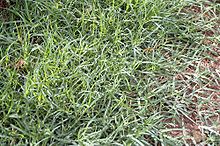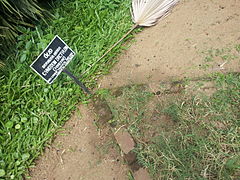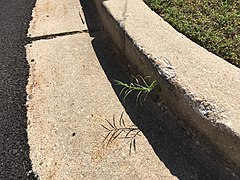Cynodon dactylon
| Cynodon dactylon | |
|---|---|

| |
| Scientific classification | |
| Kingdom: | Plantae |
| Clade: | Tracheophytes |
| Clade: | Angiosperms |
| Clade: | Monocots |
| Clade: | Commelinids |
| Order: | Poales |
| Family: | Poaceae |
| Genus: | Cynodon |
| Species: | C. dactylon
|
| Binomial name | |
| Cynodon dactylon | |
| Synonyms[1] | |
|
List
| |
Cynodon dactylon, commonly known as Bermuda grass, also known as couch grass in Australia and New Zealand, is a grass found worldwide. It is native to Europe, Africa, Australia and much of Asia. It has been introduced to the Americas.[2][3] Contrary to its common name, it is not native to Bermuda and is in fact an abundant invasive species there. In Bermuda it has been known as "crab grass" (also a name for Digitaria sanguinalis). Other names are Dhoob, dūrvā grass, ethana grass, dubo, dog grass, dog's tooth grass,[4] Bahama grass, crab grass, devil's grass, couch grass, Indian doab, arugampul, grama, wiregrass and scutch grass.
Description
[edit]
The blades are a grey-green colour and are short, usually 2–15 cm (0.79–5.91 in) long with rough edges.[5] The erect stems can grow 1–30 cm (0.39–11.81 in) tall. The stems are slightly flattened, often tinged purple in colour.
The seed heads are produced in a cluster of two to six spikes together at the top of the stem, each spike 2–5 cm (0.79–1.97 in) long.[5]
It has a deep root system; in drought situations with penetrable soil, the root system can grow to over 2 metres (6.6 ft) deep, though most of the root mass is less than 60 centimetres (24 in) under the surface. The grass creeps along the ground with its stolons, and roots wherever a node touches the ground, forming a dense mat. C. dactylon reproduces through seeds, stolons, and rhizomes. Growth begins at temperatures above 15 °C (59 °F) with optimum growth between 24 and 37 °C (75 and 99 °F); in winter or in the dry season, the grass becomes dormant and turns brown. Growth is promoted by full sun and retarded by full shade, e.g., close to tree trunks.[citation needed]
Cultivation
[edit]Cynodon dactylon is widely cultivated in warm climates all over the world between about 30° S and 30° N latitude, and that get between 625 and 1,750 mm (24.6 and 68.9 in) of rainfall a year (or less, if irrigation is available). For example, in the United States, it is grown mostly in the southern half of the country.

Cultivars
[edit]Hundreds of cultivars have been created specifically for environmental tolerance and stakeholder requirements. New cultivars are released yearly.[7][8]
Uses
[edit]Religious
[edit]Commonly known as "durva" or dūrvāyugma in India, this grass is used in the Ayurveda system of medicine.[9] Performing a rite called "the consecration of Rudra (Sanskrit Rudrabhisheka) described in the Purāṇas (Sanskrit purāṇokta) while offering durva 11 times bestows long life. In Hinduism, it is considered important in the worship of Lord Ganesha. A clump of 21 shoots of this grass is usually offered during puja (worship). It has been a part of Hindu rituals since Vedic times. A unique festival called Durga Ashtami, dedicated to this grass, is celebrated on the eighth day of Shukla Paksha of Bhadra month of the Hindu calendar.[10]
It is known as "Arugampul" in Tamil and "Karuka" in Malayalam and is part of the Dashapushpam (Ten sacred flowers) in Kerala.[11]

In Nepal, the grass is known as "dubo" and is used by the Hindus. According to Nepalese Hindus, the grass symbolises long life. The grass is an essential item for the Naga Panchami festival as well as the Gaura festival.[12][13][14] In a Nepalese Hindu wedding, a garland made of this grass is worn by both bride and groom.[15]
This grass is a Yoruba herb used for Esu or Elegba in the Ifá system of orishas.[citation needed]
Medicinal value
[edit]The rhizomes are reported to act as a diuretic in humans and the grass juice can act as an astringent.[9]
It has been observed that Cynodon dactylon may be selectively eaten by dogs to swiftly induce vomiting when they have gastrointestinal problems. The effect may be due to irritation caused by bristles on the leaf margin.[9]
Other
[edit]It is fast-growing and tough, making it popular and useful for sports fields, as when damaged it will recover quickly. It is a highly desirable turf grass in warm temperate climates, particularly for those regions where its tolerance to heat and drought enable it to survive where few other grasses do. This combination makes it a frequent choice for golf courses in the southern and southeastern United States and South Africa. It has a relatively coarse-bladed form with numerous cultivars selected for different turf requirements.[citation needed]
Bermuda grass has been cultivated in saline soils in California's Central Valley, which are too salt-damaged to support agricultural crops; it was successfully irrigated with saline water and used to graze cattle.[16][17]
Professional sports
[edit]National Football League
[edit]The following National Football League teams use it as the playing surface in their home stadiums:
- Arizona Cardinals (State Farm Stadium in Glendale, Arizona) (Tifway 419 Hybrid Bermudagrass)
- Baltimore Ravens (M&T Bank Stadium in Baltimore) (Tifway 419 Bermuda grass)
- Chicago Bears (Soldier Field in Chicago) (Tahoma 31 Bermuda grass)
- Jacksonville Jaguars (TIAA Bank Field in Jacksonville, Florida) (Tifway 419 Bermuda grass)
- Kansas City Chiefs (Arrowhead Stadium in Kansas City, Missouri) (Latitude 36 Bermuda grass)
- Las Vegas Raiders (Allegiant Stadium in Paradise, Nevada)
- Miami Dolphins (Hard Rock Stadium in Miami) (Tifway 419 Bermuda grass)
- Philadelphia Eagles (Lincoln Financial Field in Philadelphia (Tahoma 31 Bermuda grass)
- San Francisco 49ers (Levi's Stadium in Santa Clara, California) (Tifway II Bermuda grass)
- Tampa Bay Buccaneers (Raymond James Stadium in Tampa, Florida) (Tifway 419 Bermudagrass)
- Tennessee Titans (Nissan Stadium in Nashville, Tennessee) (Tifsport Bermuda sod)
- Washington Commanders (FedEx Field in Landover, Maryland) (Latitude 36 Bermuda grass)
Major League Baseball
[edit]The following Major League Baseball teams use it as the playing surface in their home stadiums:
- Los Angeles Angels (Angel Stadium in Anaheim, California) (Tifway 419 Bermudagrass)
- Los Angeles Dodgers (Dodger Stadium in Los Angeles) (Santa Ana Bermudagrass)
- Oakland Athletics (Oakland Coliseum in Oakland, California) (Tifway II Bermuda Grass)
- San Diego Padres (Petco Park in San Diego) (BullsEye Bermuda Grass)
- San Francisco Giants (Oracle Park in San Francisco) (Tifway 419 Bermudagrass)
Ecology
[edit]

Invasive species
[edit]It is a highly aggressive invasive species, crowding out most other grasses and invading other habitats, and has become a hard-to-eradicate weed in some areas (it can be controlled somewhat with Triclopyr, Mesotrione, Fluazifop-P-butyl, and Glyphosate).[18][19] This weedy nature leads some gardeners to give it the name of "devil grass". Bermuda grass is incredibly difficult to control in flower beds and most herbicides do not work. However, Ornamec, Ornamec 170, Turflon ester (tricyclopyr), and Imazapyr have shown some effectiveness. All of these items are difficult to find in retail stores, as they are primarily marketed to professional landscapers.[20]
The hybrid variety Tifton 85, like some other grasses (e.g. sorghum), produces cyanide under certain conditions,[21] and has been implicated in several livestock deaths.
References
[edit]
|
